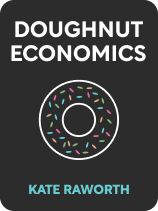

This article is an excerpt from the Shortform book guide to "Doughnut Economics" by Kate Raworth. Shortform has the world's best summaries and analyses of books you should be reading.
Like this article? Sign up for a free trial here .
Why should companies be owned by their employees? Will employee ownership work for any business?
In her book Doughnut Economics, Kate Raworth champions more collective forms of corporate governance, such as cooperatives and employee-owned enterprises. She argues that to deny workers an equity stake in the company to which they provide their valuable labor is to deprive them of what is rightfully theirs.
Here’s why employee ownership is the way to go.
Towards Employee Ownership
Raworth suggests transitioning to a system of employee-owned firms, giving workers an equity stake in the firms to which they supply their labor.
She notes that workers have seen their share of national wealth and their bargaining power decline precipitously since the dawn of the neoliberal era in the 1970s and 1980s. This has happened to varying degrees all over the world, even in highly unionized economies like Germany and the Scandinavian countries. Most firms see their sole purpose as maximizing shareholder value, with labor merely a cost—one to be minimized as much as possible.
(Shortform note: Perhaps the most well-known articulation of this theory came from economist Milton Friedman. In his famous 1970 article for the New York Times Magazine, “The Social Responsibility Of Business Is to Increase Its Profits,” Friedman championed the shareholder value maximization model. This model held that the most important measure of a company’s success was the financial returns to its shareholders. He saw any acts of “corporate social responsibility” as a misuse and expropriation of shareholders’ money on the part of well-intentioned but ultimately misguided corporate officers.)
But, Raworth writes, shareholder equity only exists because of the labor that adds value to the firm’s products and services. She proposes rewriting corporate charters to implement new and alternative forms of labor organization, such as cooperatives and employee ownership, which will give workers a greater share of national income and reorient the mission of private enterprise itself—from being profit-driven to people-driven.
| The Decline of the Stakeholder Model of Corporate Governance According to Raworth, we should transition to more collective form of corporate governance. It’s worth noting, however, that this actually did exist in the United States in the decades following World War II. In the mid-20th century, the management function within major American companies was widely diffused throughout the organizational hierarchy. A combination of executives, middle managers, and workers collectively made production and planning decisions. As a result, middle managers and workers captured a larger share of corporate value, with workers’ wages growing three times faster than those of executives. The period was marked by a high degree of upward mobility within companies, as even workers in low-skill jobs frequently had the opportunity to ascend to the ranks of management. This form of corporate management viewed the company as a partnership between multiple stakeholders—managers, workers, customers, suppliers, and shareholders. According to some commentators, the rise of management companies like McKinsey, which rose to prominence during the 1970s and 1980s, played a significant role in the decline of this relatively equitable arrangement. These consultants encouraged corporate leaders to shift toward a line of thinking which held that private companies ought to serve the interests of only one group—the shareholders. Accordingly, companies like McKinsey advised firms to downsize their middle managers, seeing them as “corporate bureaucrats” who contributed little value. This concentrated the management function—and the share of profits that accrued from it—increasingly in the hands of top executives. |

———End of Preview———
Like what you just read? Read the rest of the world's best book summary and analysis of Kate Raworth's "Doughnut Economics" at Shortform .
Here's what you'll find in our full Doughnut Economics summary :
- Why we need a top-to-bottom redesign of our global economic order
- Why long-term economic growth is unsustainable
- How inequality fuels a feedback loop that leads to more inequality






